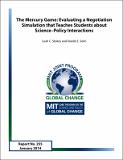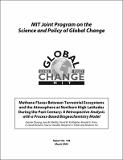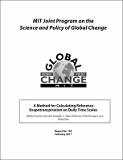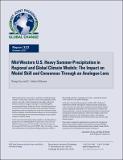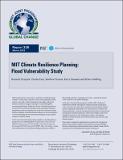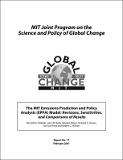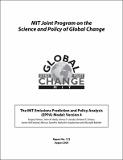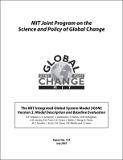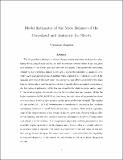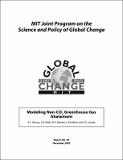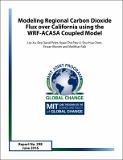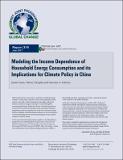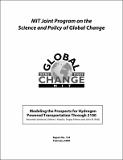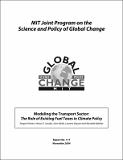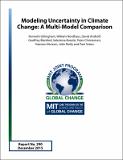Browsing Center for Global Change Science by Title
Now showing items 212-231 of 337
-
The Mercury Game: Evaluating a Negotiation Simulation that Teaches Students about Science–Policy Interactions
(MIT Joint Program on the Science and Policy of Global Change, 2014-01)Environmental negotiations and policy decisions take place at the science–policy interface. While this is well known in academic literature, it is often difficult to convey how science and policy interact to students in ... -
Methane Fluxes Between Terrestrial Ecosystems and the Atmosphere at Northern High Latitudes During the Past Century: A retrospective analysis with a process-based biogeochemistry model
(MIT Joint Program on the Science and Policy of Global Change, 2004-03)We develop and use a new version of the Terrestrial Ecosystem Model (TEM) to study how rates of methane (CH4) emissions and consumption in high-latitude soils of the Northern Hemisphere have changed over the past century ... -
A Method for Calculating Reference Evapotranspiration on Daily Time Scales
(MIT Joint Program on the Science and Policy of Global Change, 2011-02)Measures of reference evapotranspiration are essential for applications of agricultural management and water resources engineering. Using numerous esoteric variables, one can calculate daily reference evapotranspiration ... -
Mid-Western U.S. Heavy Summer-Precipitation in Regional and Global Climate Models: The Impact on Model Skill and Consensus Through an Analogue Lens
(MIT Joint Program on the Science and Policy of Global Change, 2017-10)Regional climate models (RCMs) in general can simulate the characteristics of heavy/extreme precipitation more accurately than general circulation models (GCMs) as a result of more realistic representation of topography ... -
MIT Climate Resilience Planning: Flood Vulnerability Study
(MIT Joint Program on the Science and Policy of Global Change, 2018-03)The MIT Flood Vulnerability Study is one key part of a broader initiative led by the MIT Climate Resiliency Committee (CRC) and the MIT Office of Sustainability (MITOS) to understand and recommend how MIT can continue to ... -
The MIT Emissions Prediction and Policy Analysis (EPPA) model : revisions, sensitivities, and comparisons of results
(MIT Joint Program on the Science and Policy of Global Change, 2001-02)The Emissions Prediction and Policy Analysis (EPPA) model is a component of the MIT Integrated Earth Systems Model (IGSM). Here, we provide an overview of the model accessible to a broad audience and present the detailed ... -
The MIT Emissions Prediction and Policy Analysis (EPPA) Model: Version 4
(MIT Joint Program on the Science and Policy of Global Change, 2005-08)The Emissions Prediction and Policy Analysis (EPPA) model is the part of the MIT Integrated Global Systems Model (IGSM) that represents the human systems. EPPA is a recursive-dynamic multi-regional general equilibrium model ... -
The MIT EPPA6 Model: Economic Growth, Energy Use, and Food Consumption
(MIT Joint Program on the Science and Policy of Global Change, 2015-03)The MIT Economic Projection and Policy Analysis (EPPA) model has been broadly applied on energy and climate policy analyses. In this paper, we provide an updated version of the model based on the most recent global economic ... -
MIT Integrated Global System Model (IGSM) Version 2: Model Description and Baseline Evaluation
(MIT Joint Program on the Science and Policy of Global Change, 2005-07)The MIT Integrated Global System Model (IGSM) is designed for analyzing the global environmental changes that may result from anthropogenic causes, quantifying the uncertainties associated with the projected changes, and ... -
Model estimates of the mass balance of the Greenland and Antartic ice sheets
(MIT Joint Program on the Science and Policy of Global Change, 1999-10)The six possible combinations of two climate models and three methods for calculating the melting of snow and ice are used to estimate current values of accumulation and ablation on the Greenland and Antarctic ice sheets. ... -
Modeling Climate Feedbacks to Energy Demand: The Case of China
(MIT Joint Program on the Science and Policy of Global Change, 2006-06)This paper is an empirical investigation of the effects of climate on the use of electricity by consumers and producers in urban and rural areas within China. It takes advantage of an unusual combination of temporal and ... -
Modeling non-CO₂ greenhouse gases
(2002-12)Although emissions of CO₂ are the largest anthropogenic contributor to the risks of climate change, other substances are important in the formulation of a cost-effective response. To provide improved facilities for addressing ... -
Modeling Regional Carbon Dioxide Flux over California using the WRF‑ACASA Coupled Model
(MIT Joint Program on the Science and Policy of Global Change, 2016-07)Many processes and interactions in the atmosphere and the biosphere influence the rate of carbon dioxide exchange between these two systems. However, it is difficult to estimate the carbon dioxide flux over regions with ... -
Modeling regional transportation demand in China and the impacts of a national carbon constraint
(2015-01-30)Climate and energy policy in China will have important and uneven impacts on the country’s regionally heterogeneous transport system. In order to simulate these impacts, transport sector detail is added to a multi-sector, ... -
A modeling study on the climate impacts of black carbon aerosols
(MIT Joint Program on the Science and Policy of Global Change, 2002-03)The role of black carbon (BC) aerosols in climate change is important because of its strong capability in causing extinction of solar radiation. A three-dimensional interactive aerosol-climate model has been used to study ... -
Modeling the Global Water Resource System in an Integrated Assessment Modeling Framework: IGSM-WRS
(MIT Joint Program on the Science and Policy of Global Change, 2010-09)The availability of water resources affects energy, agricultural and environmental systems, which are linked together as well as to climate via the water cycle. As such, watersheds and river basins are directly impacted ... -
Modeling the Income Dependence of Household Energy Consumption and its Implications for Climate Policy in China
(MIT Joint Program on the Science and Policy of Global Change, 2017-07)We estimate Engel Curves based on Chinese household microdata and show in general equilibrium simulations that they imply substantially lower energy demand and CO2 emissions, relative to projections based on standard ... -
Modeling the Prospects for Hydrogen Powered Transportation Through 2100
(MIT Joint Program on the Science and Policy of Global Change, 2008-02)Hydrogen fueled transportation has been proposed as a low carbon alternative to the current gasoline-powered fleet. Using a computable general equilibrium model of the world economy we explore the economic viability of ... -
Modeling the Transport Sector: The Role of Existing Fuel Taxes in Climate Policy
(MIT Joint Program on the Science and Policy of Global Change, 2004-11)Existing fuel taxes play a major role in determining the welfare effects of exempting the transportation sector from measures to control greenhouse gases. To study this phenomenon we modify the MIT Emissions Prediction and ... -
Modeling Uncertainty in Climate Change: A Multi-Model Comparison
(MIT Joint Program on the Science and Policy of Global Change, 2015-12)The economics of climate change involves a vast array of uncertainties, complicating both the analysis and development of climate policy. This study presents the results of the first comprehensive study of uncertainty in ...

